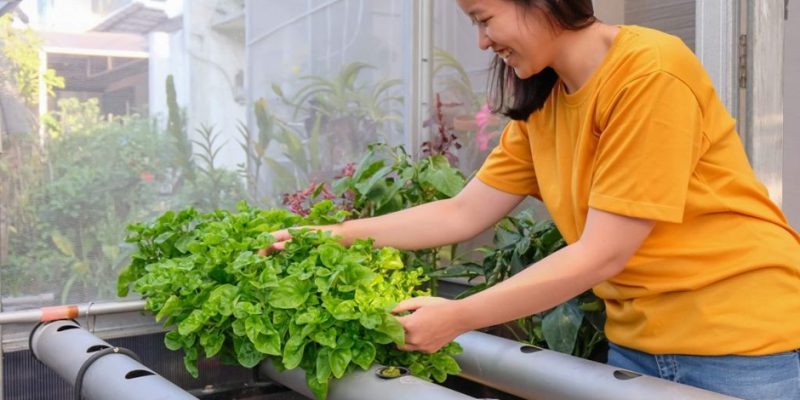In recent years, the concept of hydroponic gardening has gained immense popularity among urban dwellers and gardening enthusiasts alike. Hydroponics offers a versatile and efficient way to grow plants without soil, using nutrient-rich water solutions instead. Whether you’re limited by space or seeking a sustainable gardening method, starting a hydroponic garden at home can be a rewarding endeavor. This comprehensive guide will walk you through the steps to kickstart your hydroponic journey, from setting up the system to nurturing your plants for optimal growth and harvest.
1. Choose the Right System
When selecting a hydroponic system, take into consideration things such as space availability, your gardening experience, and the specific plants you wish to grow. For beginners or those with limited space, a simple system like the Kratky method or a deep water culture setup may be ideal. These systems require minimal maintenance and are relatively inexpensive to set up. On the other hand, if you’re experienced and looking to maximize yield in a larger space, you might opt for a more complex system like nutrient film technique (NFT) or aeroponics. These systems offer exact management over nutrient delivery. Furthermore, they can accommodate a wide variety of plants. Whichever system you choose, ensure it aligns with your goals and resources to set yourself up for success in your hydroponic gardening journey. So, be mindful of these factors when searching for a hydroponic system for sale.
2. Gather Essential Supplies
Once you’ve chosen a hydroponic system, gather all the necessary supplies to set it up. This typically includes containers or reservoirs for holding the nutrient solution, growing medium (such as perlite or clay pellets), nutrient solutions tailored to the specific needs of your plants, a pH testing kit, and an appropriate lighting system if you’re growing indoors.
3. Set Up the System
Setting up your hydroponic system is a crucial step in ensuring the success of your garden. Start by selecting a suitable location with access to electricity and adequate lighting, whether it’s a sunny spot near a window or an indoor grow space equipped with grow lights.
Next, assemble the components of the hydroponic system you chose according to the instructions made by the manufacturer or guidance from reliable online resources. Pay close attention to details such as the arrangement of grow trays, placement of pumps and tubing, and installation of reservoirs or nutrient tanks.
Once the system is assembled, make sure the reservoir is filled with water, and then pour in the fitting hydroponic nutrient solution by using the recommended dilution rates. Use a pH testing kit to adjust the pH level of the nutrient solution to the optimal range for your chosen plants, typically between 5.5 and 6.5.
4. Choose Suitable Plants
When selecting plants for your hydroponic garden, it’s essential to consider their adaptability to soilless environments and their space requirements. Leafy greens such as lettuce, spinach, and kale are excellent choices for beginners due to their rapid growth and relatively low maintenance needs. Herbs like basil, cilantro, and parsley also thrive in hydroponic systems, providing fresh flavors to enhance your culinary creations.
For those with more space and experience, consider experimenting with vine crops like tomatoes, cucumbers, and peppers. While these plants may require additional support and care, they can yield abundant harvests of delicious fruits with proper attention.
Additionally, research the specific nutrient requirements of each plant to ensure they receive the essential elements they need for healthy growth. Many hydroponic gardening guides provide recommendations for nutrient solutions tailored to different types of plants, helping you optimize your garden’s productivity. However, if you live in a high-humidity area, we recommend taking a look at the LA Times article about the best plants in this climate.
5. Monitor and Maintain
Constant checking and maintenance are key to ensuring the well-being and productivity of the hydroponic garden. Remember to consistently make sure the pH and nutrient levels of the water solution are normal. Adjust lighting and airflow as needed, and keep an eye out for signs of pests or diseases. Proper maintenance will help prevent issues and promote vigorous growth throughout the growing season.
6. Harvest and Enjoy
As your hydroponic plants mature, you’ll soon be rewarded with a bountiful harvest of fresh, flavorful produce. Harvest your crops regularly to encourage continuous growth and enjoy the satisfaction of knowing that you’ve grown your own food using innovative gardening techniques. Whether you’re enjoying crisp salads, fragrant herbs, or juicy tomatoes, the fruits of your hydroponic labor are sure to delight your taste buds.
Conclusion
All in all, starting a hydroponic garden at home opens up a world of possibilities for aspiring gardeners and urban farmers. By following these simple steps and embracing the principles of hydroponic gardening, you can cultivate a thriving oasis of greenery and produce right in the comfort of your own home. Get ready to embark on an exciting journey of discovery and growth as you explore the endless potential of hydroponic gardening!












Comments